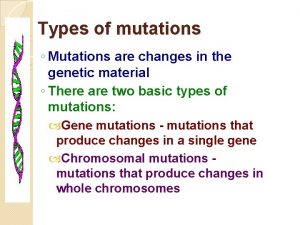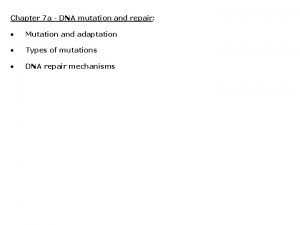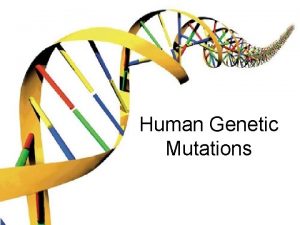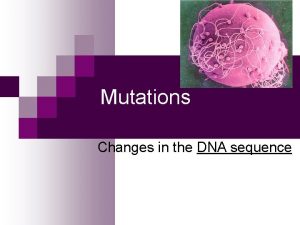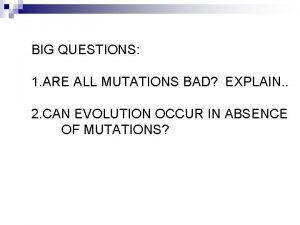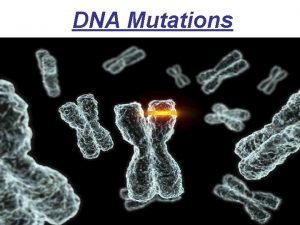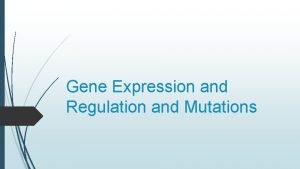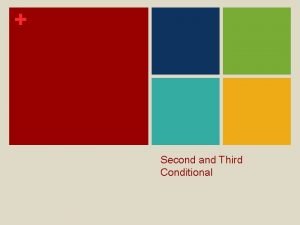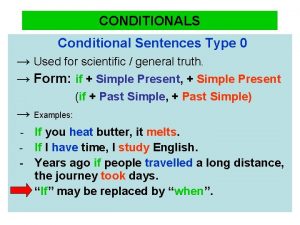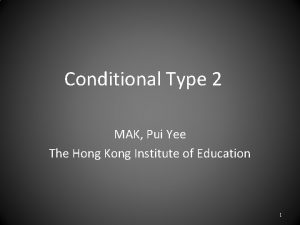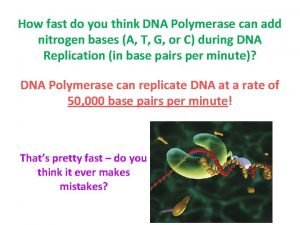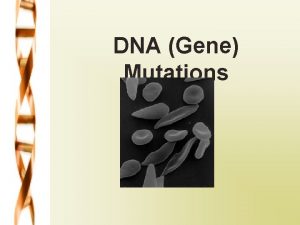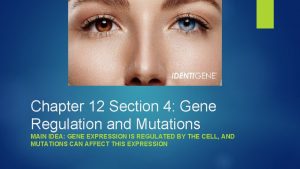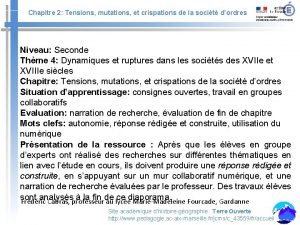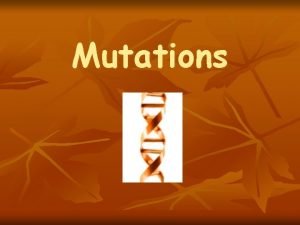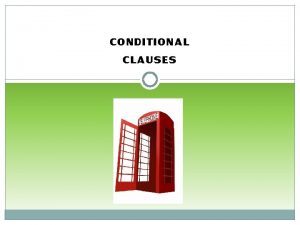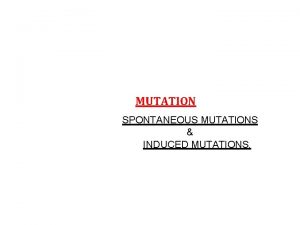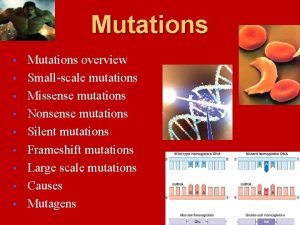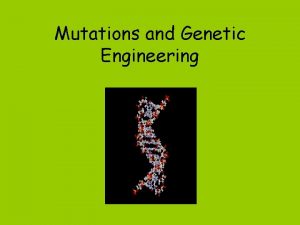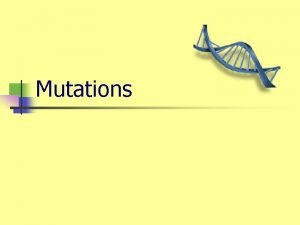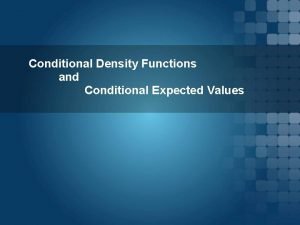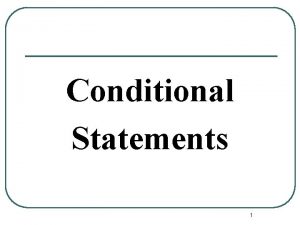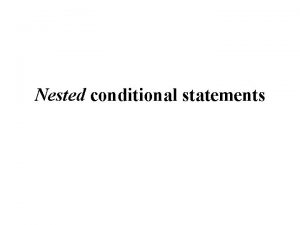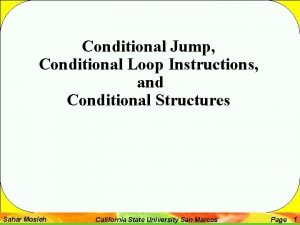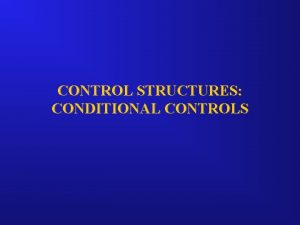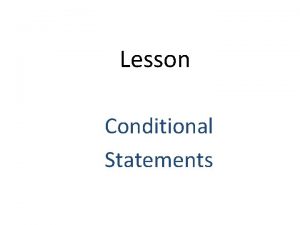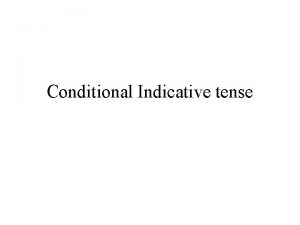Types of mutations Point mutations Conditional mutations Point






















- Slides: 22

Types of mutations • Point mutations • Conditional mutations

Point mutations • In point mutations the sequence of the DNA has been altered at a single position. Where this change consists of replacing one nucleotide by another, it is known as a base substitution. • The consequence of such a change depends both on the nature of the change and its location.

• If the change is within the coding region of a gene (i. e. the region which ultimately is translated into protein), it may cause an alteration of the amino acid sequence which may affect the function of the protein. • The alteration may of course have little or no effect, either because the changed triplet still codes for the same amino acid or because the new amino acid is sufficiently similar to the original one for the function of the protein to remain unaffected.

For example: • the triplet UUA codes for leucine; a single base change in the DNA can give rise to one of nine other codons: • CUA , UUG are completely silent, as the resulting codons still code for leucine. These are known as synonymous codons. • AUA and GUA may well have little effect on the protein since the substituted amino acids (isoleucine and valine respectively) are similar to the original leucine (they are all hydrophobic amino acids)

• Phenylalanine (UUC or UUU codons) is also hydrophobic but is more likely to cause a significant change in the structure of the protein at that point. • The significance of the change to UCA, resulting in the substitution of serine (which is considerably different) for leucine will depend on the role played by that amino acid (and its neighbours) in the overall function or conformation of the protein.

• The final two changes (UGA , UAA) • are referred to as stop or termination codons (as is a third codon, UAG), • since they result in termination of translation; there is normally no t. RNA molecule with the corresponding anticodon.

Types of point mutations • A nucleotide-pair substitution: replaces one nucleotide and its partner with another pair of nucleotides • Silent mutations have no effect on the amino acid produced by a codon because of redundancy in the genetic code • Missense mutations still code for an amino acid, but not the correct amino acid • Nonsense mutations change an amino acid codon into a stop codon, nearly always leading to a nonfunctional protein


Nucleotide –pair substitution : missense

Nucleotide –pair substitution : nonsense

• A different kind of mutation still involving a change at a single position, consists of the deletion or addition of a single nucleotide (or of any number other than a multiple of three). • This is known as a frameshift mutation, since it results in the reading frame being altered for the remainder of the gene. Since the message is read in triplets, with no punctuation marks (the reading frame being determined solely by the translation start codon), an alteration in the reading frame will result in the synthesis of a totally different protein from that point on.

Nucleotide –pair insertion or deletion: immediate nonsense

Nucleotide –pair insertion or deletion: extensive missense

Conditional mutations • There are many genes that do not affect resistance to antibiotics or bacteriophages, biosynthesis of essential metabolites or utilization of carbon sources. Some of these genes are indispensable and any mutants defective in those activities would die (or fail to grow).

DNA modification repair pathways • Repair pathways that remove DNA modifications have Three basic mechanisms: 1 -direct repair 2 -base-excision repair 3 -nucleotide-excision repair.

1 -Direct chemical reversal 1. Photolyase, AKA photo-reactivation. UV light induces the formation of pyrimidine dimers between adjacent C or T bases in DNA. The photolyase enzyme break the cyclobutane dipyrimidine bond. To do so, the enzyme must absorb visible light, hence the name photoreactivation. E. coli and the yeast Saccharomyces cerevisiae have such an enzyme. 2. Methyltransferase. The methyl groups from mutagenic O 6 -methylguanine (O 6 -Me. G is particularly mutagenic) and O 4 -methylthymine can be removed directly by this enzyme.

2 - base-excision • Glycosylase + AP endonuclease. • Many modified bases are recognized by specific Nglycosylases that cleave the modified base. • The resulting AP site is repaired by : AP endonucleases. Examples in E. coli: hypoxanthine-DNA glycosylase, 3 methyladenine glycosylase. formamidopyrimidine glycosylase, hydroxymethyl glycosylase

3 - Nucleotide excision repair • In this form of DNA repair, the damaged bases are removed from DNA as an oligonucleotide and the resulting gap is repaired by resynthesis. • This pathway is used to remove many bulky adducts in DNA, including crosslinks and UV-induced pyrimidine dimers

Nucleotide excision repair = enzymes that function to cut out and replace DNA damage

Mutation Rate • Mutation rate is a probability that gene will mutate when cell divides. • A mutation rate has evolved in cells that is very low yet detectable. This allows organisms to balance the need for genetic stability with that for evolutionary improvement.

• The fact that organisms as phylogenetically disparate as hyper thermophilic Archaea and Escherichia coli have about the same mutation rate might make one believe that evolutionary pressure has selected for organisms with the lowest possible mutation rates. However, this is not so. The mutation rate in an organismis subject to change. For xample, mutants of some organisms have been selected in the laboratory that are hyperaccurate in DNA replication and repair.

• However, in these strains, the improved proofreading repair mechanisms has a significant metabolic cost; thus, a hyperaccurate mutant might actually be at a disadvantage in its natural environment. • On the other hand, some organisms seem to benefit from a hyperaccurate phenotype that enables them to occupy particular niches in nature. • A good example is the bacterium: • Deinococcus radiodurans. This organism is 20 times more resistant to UV radiation and 200 times more resistant to ionizing radiation than E. coli.
 Types of mutations
Types of mutations Syndrome triple x
Syndrome triple x Types of substitution mutations
Types of substitution mutations Tautomeric shift mutation
Tautomeric shift mutation Dna types of mutations
Dna types of mutations Are all mutations bad? explain
Are all mutations bad? explain Types of mutations
Types of mutations Gene
Gene First conditional de ask
First conditional de ask Past conditional
Past conditional Four types of conditional sentences
Four types of conditional sentences Type zero conditional
Type zero conditional Conditionals type 0
Conditionals type 0 Youtube.com
Youtube.com Conditionals type 3
Conditionals type 3 Conditional 4
Conditional 4 What are some neutral mutations
What are some neutral mutations Dna vs rna worksheet answer key
Dna vs rna worksheet answer key What can cause mutations
What can cause mutations Chapter 14 lesson 4 mutations
Chapter 14 lesson 4 mutations Chapter 12 section 4 gene regulation and mutations
Chapter 12 section 4 gene regulation and mutations Tensions mutations et crispations de la société d'ordres
Tensions mutations et crispations de la société d'ordres Helpful mutation
Helpful mutation

